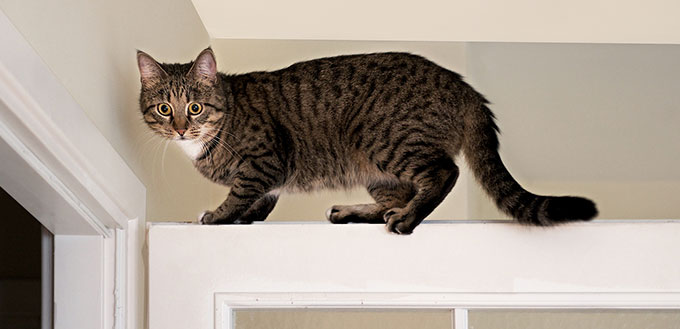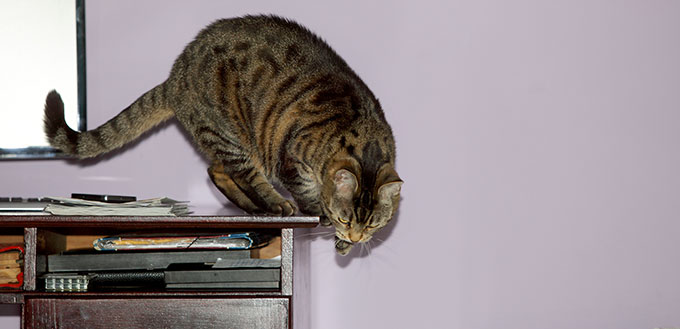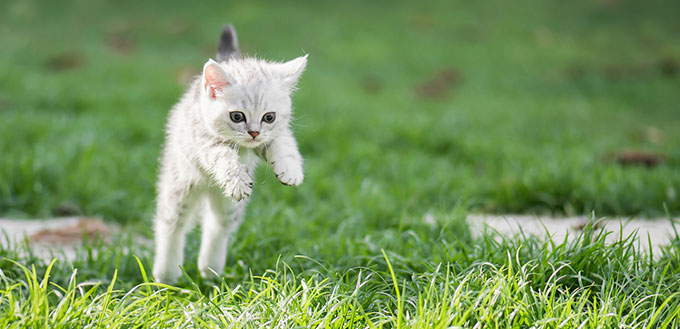Our feline friends are famously agile, but how do they pull it off? You’ve probably heard the old adage that cats always land on their feet, and if you’ve ever witnessed your pet fling themselves from the couch only to twist their way to a graceful landing, you can probably see why.
If you’ve ever wondered how and why our cats seem to have this almost supernatural ability, read on. Today, we’re tackling the question of whether, and if so how, cats always land on their feet.
A Long-Standing Mystery
So, why do cats always land on their feet? Essentially, it’s all in their flexible spine.
How cats could land on their feet was actually a question that has puzzled some famous physicists through the ages. In the 19th century, for instance, James Clerk Maxwell—famous for his work on electromagnetism—regularly threw cats out of windows and watched them fall in a bid to understand the feline self-righting mechanism.
Physicists like Maxwell were puzzled by the cat’s seeming ability to violate the law of conservation of angular momentum. In Physics, this law explains that a moving object will keep rotating in the same direction unless it’s influenced by an outside force.
In order to turn around, cats would apparently need something to push against—but in mid-air, there’s nothing.
Because cats can wrangle themselves into a standing position no matter how they fall, and aren’t being righted by an outside force in mid-air, it seemed as if they were breaking this universal law.
In reality, of course, they weren’t. In the 1890s, cutting-edge high speed photography of cats landing on their feet revealed what was happening when cats right themselves in the air.
A Flexible Solution
Looking at the problem from a purely physics-based standpoint ignored some important information. Cats are not the rigid ‘bodies’ of classical physics, and their flexible anatomy offered a clue.
If you’ve ever seen your feline worm its way into an impossibly tight space, or escape under the narrowest of cracks, you’ll already know just how malleable their bodies can be.
This flexible spine, paired with strong muscles, plays out mid-air as a cat works to right itself. Cats have more vertebrae than us humans, and ss they fall, can twist their spine in opposite directions at once.
This action allows them to basically ‘push against’ themselves, and so change their direction. When they achieve the correct orientation they can simply straighten out their spine, and land.
Recent slow motion footage shows that some species of cat go even further. The African Caracal cat is a powerful jumper, and can reach great heights hunting prey. Like other cats, they use the spine twisting method to reorientate their body in mid air.
To reach the correct position faster, though, they actually employ the same technique as an ice dancer. After twisting its spine, a Caracal will pull its front legs in close to its body.
Because of the conservation of momentum, this causes its front part of its body to twist faster, and deepen the twist in its spine so it can swing its back legs around more quickly.
Designed for Acrobatics
Most cats can right themselves when dropped from a height of just 12 inches off the ground. They can also, on average, survive falls from about 6 stories up, although some animals have, incredibly, recovered from falls as high as 32 stories up.
A cat’s flexible spine isn’t the only physical adaptation that helps it land safely. They have relatively small bodies, as well as a light bone structure and thick fur. These characteristics add up to a reduced terminal velocity.
Cats’ light weight reduces the speed at which they fall, while thick fur increases air resistance and softens their landing. Cats have even been known to take this concept further by stretching their bodies into a sort of ‘parachute’ shape that creates even more air resistance, reducing their falling speed hence risk of injury.
A Balancing Act
We have seen that cats use their strong, flexible spines to right themselves as they fall, but falling at such high speeds, how do they keep their balance, and always know which way is up?
Cats have an incredible sense of balance that us humans could only dream of. Some of it comes down to visual cues, but ultimately, it’s a cat’s vestibular apparatus that allows them to pull off such impressive landings.
The vestibular apparatus is a set of fluid-filled canals in the inner ear that contains various nerve cells and receptors. When a cat moves its head, the fluid moves, too, and this movement is picked up by receptors and transported via nerve impulse to the brain.
The brain will automatically send a signal to the muscles on one side of the body to adjust from the change in position, which prevents the cat from falling over.
Humans have a similar setup, but it’s not as sophisticated.
In the air, this sophisticated mechanism allows the cat to work out its orientation in relation to gravity, and begin the righting process.
What Can Make a Cat Clumsy?
If you search ‘cat landing on its feet’ you’ll come across animals as young as seven weeks old falling and landing using the twisting technique.
However, things can go wrong with a cat’s sense of balance. Because the typical feline lifestyle involves leaping about trees or furniture, it’s important to keep an eye out for signs of trouble in the balance department.
Cats can lose their balance for a few clinical reasons:
- Ear infections, which interfere with the vestibular apparatus
- Vestibular disease, which can be triggered by various underlying causes
- Poisoning
- A brain disease that affects muscle control
If your cat is suddenly having difficulty with their balance, consult your vet as soon as possible.
Sources:
- Cat High-Rise Syndrome: Falling From High Places, WebMD
- Why Do Cats Have Good Balance?, Vetstreet
- Lynn Buzhardt, DVM, First Aid for Falls in Cats, VCA Hospitals










